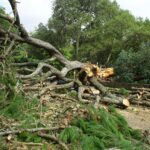At a glance:
- Benefits of mulching
- Effective ways to apply mulch
There are several forms of tree services ranging from tree pruning, tree lopping, stump removal, and branch removal to tree removal. Same Day Tree Works specialises in these tree care services and has served greater Melbourne and its suburbs for many years. They employ industry compliance equipment and have full insurance covering public liability, workers’ compensation, vehicle protection, and tool and plant insurance in case of any unlikely accident. For affordable and reliable tree care services in Melbourne and surrounding suburbs, you can rely on Same Day Tree Work services.
These branches of tree care services are effective in handling diseased or dead trees, overgrowing trees (creating a nuisance in your garden), and improving your vegetation’s overall health and aesthetics. While these tree care services imply operating on the tree itself, mulching is a discrete tree care approach from those, and it involves improving the condition of the soil around your vegetation. If you have trees or other vegetation on your property, you will likely be familiar with mulching.
Mulching: Things to Know
Mulching is a protective covering left or spread on the ground over your vegetation. Mulching improves the quality of your vegetation by improving soil conditions and preventing weed growth. Maintaining soil conditions like temperature, nutrients, and water is important to govern the overall health and growth of vegetation. Mulching deals with these aspects of tree care simultaneously, making mulching a beneficial and compelling aspect of gardening and tree maintenance. Before you mulch your vegetation, there are several things about mulching you should consider knowing beforehand.
The covering (organic or inorganic) laid or spread over the ground surface is called mulch. If you are applying mulch to your groundcover, you must become familiar with the types of mulch that determine the purpose behind using mulch for your vegetation. There are two types of mulch; organic and inorganic mulch.
Organic Mulch
As the name suggests, organic mulch is any organic ground cover. This is usually made from leaves, compost, and shredded organic matter like barks or branches of trees, grain straw, or buckwheat and rice hulls. Mostly tree wastage like fallen leaves, barks, or branches is used as organic mulch for mulching. With soil covering, regulating temperature, trapping soil water, and weed control, organic mulch stimulates plant growth as they are rich in nutrients.
Inorganic Mulch
Inorganic mulches are made from crushed stone, brick chips, marble, gravel, landscape fabric, and black and silver plastic. People often used crushed stone as inorganic mulch for their vegetation. Inorganic mulch has a similar purpose as organic mulch; they do not help stimulate plant growth as they lack the nutrients for plant growth. In contrast, organic mulches require changing (they decompose after a certain period), and inorganic mulches do not last long.
Using Shredded Branches for Mulching
Using parts of trees is highly effective when preparing mulches. Using shredded branches for mulching makes the process more fruitful. You can use branches saved from trimming to prepare mulch for your garden. Shredded wood chips decompose slowly compared to compost and leave mulches, so they last longer. They also prevent the growth of most weeds in gardens.
If you apply shredded branches as mulch, avoid filling the mulch dip in the soil. When decomposed, the mulch can create temporary nitrogen deficiency (plants need nitrogen to grow).
Applying Mulches: The Effective Way
Mulching does wonders for our landscape. It controls weed growth, prevents soil moisture happening from evaporation, and prevents soil erosion. This way, it keeps your ground cover healthy means providing a favourable-sustainable environment for plant growth. Mulch is a great thing (vegetation-friendly stuff), but like many things, mulches have their downsides. So you have to be careful while applying mulch to your vegetation.
- Before applying mulch, make sure the area is free of weeds.
- You can apply mulch as far as tree branches spread. But keep it shallow. Using aggressive and thick mulches blocks water flow from the surface to the soil (infiltration) and soil to the surface (evaporation). Trapping too much water and moisture can cause roots to rot or allow fungus growth in roots.
- Prevent mulch from touching tree trunks. Consider keeping mulches 3 inches away from the trunk.





